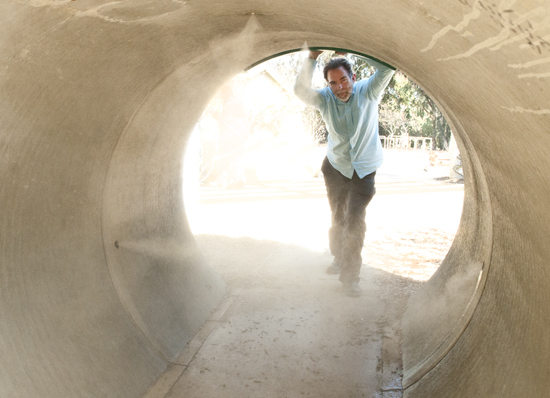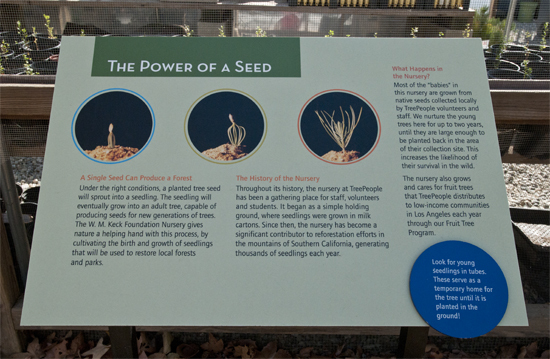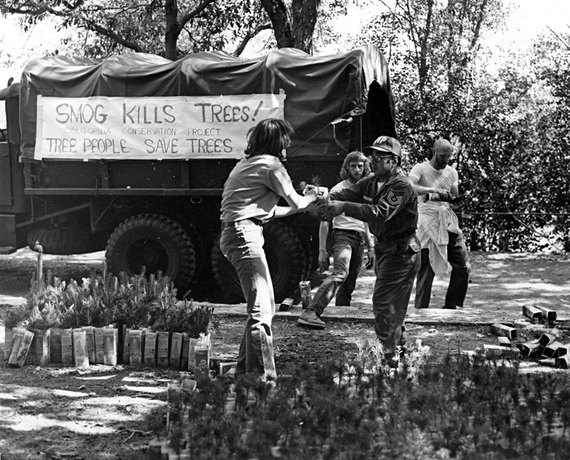Andy Lipkis founded TreePeople, a non-profit that heals our cities through the power of trees, people, and nature. Andy's teenaged drive to repair the smog-damaged woods of the local mountains became a 40-year passion for addressing pollution, drought, and global warming through systems that mimic natural forests. In this two-part interview at TreePeople's headquarters in the Santa Monica Mountains parkland, he discusses urban forests and watershed, the beliefs guiding his work, and how individuals can make a difference for good.
Part One: Early days and the importance of involving young people.
Q: Four decades! What keeps you going?
A: I pull my energy from the ground and sky. Although we humans are destroyers of the planet, we are also miraculous beings fed immense energy -- solar, love, power, compassion, passion -- the energy is there to feed us and keep us going. Everything has a job, every rock, bug, or person. We all have individual and broadband roles to play with these gifts. We are often told we don't count, but we do. When you plug into your dreams and your idea of what attracts you, and then act on those dreams, it feeds you, and recycles your energy. That's part of the sustainability machine. You find yourself supported and fed, and that will keep you going.
LA is more changeable by us than we believe and know. Most kids and people are told, "This was built on someone else's dream." But the city is always changing, even when we put the whole thing in concrete and build freeways. They can come down. Other cities have done this. The city is much more malleable than we think.

"We are fed with so much energy -- solar, love, power, compassion, passion." Andy at the TreePeople demonstration garden, inside the type of pipe used for storm drains. Ariellbphoto.com
Q: There is a Sierra Club book, Tree Boy, written about you when you were a teen-ager. How did community urban forestry become your life's work?
A. I was always planting and gardening. The first book I ever took out of elementary school library was a book on Luther Burbank.
Growing up in Los Angeles, I went to summer camp in the forest to escape the city. When I was 15, rangers told us that air pollution was killing trees, and that if nothing changed, by 2000 the forests would be dead. The rangers challenged us to do something. I led a project to get seedlings of smog-resistant trees, and we spent the next summer helping replace Ponderosa and other pines that were sensitive to smog with sugar and Coulter pines. We spent the summer breaking rocks, digging, and planting.
Q: Why are activism and engagement important for young people?
A: It was such a powerful summer working with other teens -- we saw life come back from a dying piece of the world. We helped save a forest, and we kids got a chance to see our power -- our hands and creativity could do that. We need to give kids a taste of success so they can apply it to what they are dreaming. We developed environmental education programs for camps, and then brought them to schools. Now TreePeople has one of the biggest environmental education programs in the country.
Q: How did you educate yourself?
A: I never graduated college. Most of my learning came from asking people, respectfully usually. I asked the foresters; I wanted to plant trees in the forest, and they told me it wouldn't work. So I asked them to tell me how it would work. Ultimately they began to tell me more and more what I needed to do: they critiqued me and they would tell me I was getting closer. "How would you do it? How can I do that?" I always tried to find people who know.
Q: How, as a teenager, did you move forward with your dream?
A: When I began, I tried and failed for three years to make something happen. There were so many challenges. Dealing with government agencies, raising money to pay for the seedlings and materials. I was convinced I didn't have what it took; I wasn't persistent, I tried and quit several times, quit and tried to recover from the pain. But that was an okay process. I didn't really quit, I just let go and the dream came back. I would still continue to dream and build and think. All projects take time and energy -- any dream or vision -- you have to feed it and give it time.
The process of problem-solving was the gift of my parents. Whenever I shared an odd dream, there was a part of me that knew, "Don't be silly," and another part was without judgment, asking, "How would you make that happen?" That put me into problem-solving mode. Sometimes we forget to teach kids how to struggle. It's important that we teach them persistence.
People always have and still do tell me that my ideas can't and won't happen. As a kid I was angry, my attitude was, I will show you mofo! Now my attitude is, let me demonstrate. People don't see and understand until we draw the drawing or spend years doing the economics to show it's possible.
Q: As teachers, we have seen your ability to inspire young people to activism. What gifts do young people offer?
A: Kids are gifted with seeing the world as it could be. They haven't been beaten down by the dominant reality. Often their perspective is exactly what's needed.
It's important to celebrate what young people have accomplished and share their stories. Young people have made more change than many people think.
Kids are powerful agents; they are ready to change on a dime. They understand networking; adults are slow to get that. Kids come in with the ability to think smart and electronically. It's their world. And it's their job to help adults adapt and change, like they help their parents stop smoking. Schoolchildren built our curbside recycling program. Who would have dreamed that kids would build such a massive program? Children are inherently better systems thinkers, and the computer has helped. We can help move them to ecosystem managements thinking.
Q: How have kids contributed to your programs?
A: We are told kids don't have power, the smallest have the least power, that all the money is at the top. But in the 1980's, we learned with our curbside recycling program that as kids teach their parents how to recycle, the rates go way up. Nationally, the recycling rate was 10 percent when we started our program. It was clear that people didn't understand recycling. We challenged school kids to make it happen, and the city paid for us to take students into the hills, to see them filled with critters instead of landfill. There are so many languages involved in the Los Angeles school district. We used the idea of critical mass and reached 250,000 students who translated for their families and encouraged them to recycle. The idea went viral, with 90 percent participation at the program's rollout, and rather quickly our program became the largest and most effective in the country. That happened because kids delivered; otherwise the program would have gone away. We told the city, "Recycling won't happen without the kids."
Q: It's easy to feel human damage to the environment has gone too far to repair. Is it too late for our earth?
A: Understanding the impact of climate change on our lives and the earth's systems often feels way too heavy to confront. It sends us into denial. The quality of life and opportunities are being profoundly impacted. When we lay out what's happening, people are in tears.
But we also know we can change it and do some confronting -- not to create pain, but to understand enough to engage. Even though we have done a lot of damage, the earth is regenerative. Everything I am doing is designed to have a maximum number of people make things different as soon as possible. No matter how big a problem is, we can find a way to nibble at it, find the little root or wedge; start to turn other people on. Our first responders in making a sustainable city are the DIY'ers and the people helping their neighbors.

"The first deep root that comes from a seed is like the beginning of a dream growing." At the TreePeople park. Ariellbphoto.com
Q: How can one person "make a difference?"
A: I don't like to hear people talk about some particular or important person making a difference -- we all make a difference all the time by the choices we make, the way we spend money, whether we get in our car or on a bus, the way we are in the world. It's not that a few people make a big difference. We all do, all the time.
Q: How does change happen?
A: The radical, the most vulnerable part of a plant, is the first deep root that comes out from a seed. It's like the beginning of the dream growing. You may need power, force, and money, but one of the most powerful things, and why it's called radical, is that little tiny thing that finds its way through cracks, produces acid, and forces its way through ground. Starting with a tiny hole, it can eventually crack and break rocks and move a mountain.
The largest living thing on planet is giant living sequoia. They live thousands of years. We look up to them. At that size fire doesn't kill them. That tree comes from one of the smallest seeds, it's nearly microscopic, and so vulnerable -- anything can crush kill or destroy it. It hangs out and persists through snow, fire, bears stepping on it, and is strengthened by bruising. The big, big things I have done and created started out seeming impossible, often saying to people, "No way, we won't let that stop us."
Q: Do you have any advice for staying engaged?
A: Give your project time but continue to work on it, work towards it. I'm not saying to never stop -- you need to rest, recover, reflect -- big projects can be divided into tiny steps and wins. I could always keep planting even while people said no to big stuff. That process fed me enough to keep me from getting fully discouraged. I can get angry or discouraged but continue to take a small positive action. Each step is another step forward, and provides enough hope and encouragement to keep me hoping and dreaming and moving forward.
Over time, I have often run into people who were angry and didn't want to help -sometimes they had the biggest dreams and they were in pain from letting go of their dreams. I reminded them of their lost dreams and that made them angry. But I can hang out with them and help them reopen their hearts and get back in touch with their dreams. Bureaucrats. All kinds of people.
To learn more, visit www.treepeople.org.
Andy is speaking Saturday evening, March 22, at 7:30 pm, on "Engaging Nature and Community to Protect and Heal our Cities."
About Learning Los Angeles: We are two longtime teachers and native Angelenos who love to discover the hidden gems in our favorite city. In this series, we interview local heroes behind our favorite places and events, and bring you stories of those who contribute beauty, steward nature, share their culture and inspire us. Find us on Facebook.
